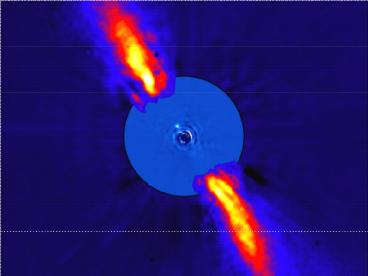Direct Imaging of Extrasolar Planets Overview of Ground - PowerPoint PPT Presentation
Title: Direct Imaging of Extrasolar Planets Overview of Ground
1
Direct Imaging of Extrasolar PlanetsOverview
of Ground Space ProgramsAnthony Boccaletti
Obs. Paris-Meudon
2
Outline
1. A brief introduction to the high contrast
imaging problematic 2. A brief review of
projects (talks to follow) 4. Where do we
need to direct our effort
3
No longer a dream !
2M1207 5 MJ 46 AU
GQ Lup 17 MJ 100 AU
AB Pic 14 MJ 248 AU
CHRX73 12 MJ 210 AU
HN Peg 16 MJ 795 AU
DH Tau 12 MJ 330 AU
RSX 1609 8 MJ 330 AU
Detection was made possible because - small
mass ratios (contrast is lower) - young ages
(planet is brighter) - large physical / angular
separations
4
A few more last week
HR8799 b 5 MJ 46 AU
HR8799 c 12 MJ 330 AU
HR8799 d 8 MJ 330 AU
Fomalhaut lt 3 MJ 120 AU
5
Problematic
STOP !!!! What about diffraction ???
Planets are faint and close .
109 1 milliard
106 1 million
Reflected light
Thermal emission
6
Problematic
Stellar images are not point-like
7
Solutions to reduce diffraction
We need BIG telescopes
We need to attenuate the star
Yes but the Sun is an extended source Stars
are point sources gt diffraction is much stronger
We need more performant stellar coronagraphs to
attenuate stars
8
In Theory
9
We are working on it ..
10
Problematic (again)
Instruments are not perfect . unfortunately
- Many defects
- - atmospheric turbulence for ground based
telescopes - static (more or less) optical aberrations
- variation of transmission
- alignment
- chromaticity
gt Limits the performance of coronagraphs
11
Solutions to reject speckles
Wavefront Correction at focal plane -
speckles minimization - Self Coherent Camera
- Wavefront Calibration
- Differential imaging
- spectral (SDI, SD)
- angular (ADI)
- polarimetric (PDI)
12
Planned Projects
13
Planet Finders on 8m telescopes (2011)
eXtreme AO coronagraphy differential
imaging
HiCIAO
European Consoritum, VLT - Dual band NIR camera
(YJHK) - NIR IFS (YJH) - Dual Polarisation VIS
camera
- Japan, Subaru
- Dual band NIR camera
- Dual polarisation NIR camera
- HiCIAO (in dev., 2010)
- Focal Plane WF
- coronagraph improvement
- - NIR IFS
- US, Gemini South
- NIR IFS (YJH)
- Focal Plane
Looking at Giant Planets in - young
associations of stars (10 Myrs lt100pc) - stars
with known planets (RV surveys) - stars of
intermediate age (0.1-1 Gyr) - very nearby bright
stars
14
James Webb Space Telescope (2014)
MIRI
SPICA
MIRI Europe US consortium 5 - 28 ?m imager
IFU MIRI imager has 4 coronagraphs 4QPM in 3
filters (10.6, 11.4, 15.5 ?m) gt self luminous
mature giants T gt 300-400K (5 - 10AU, 10pc,
5Gyr) Expected contrast 104 - 105 -
photometry (R20)
NIRCAM
FGS - TFI
CSA responsabilty 1 - 5 ?m tunable filter with
coronagraphic capabilities (Spectral
Deconvolution) - spectra (R100)
15
Extremely Large Telescopes (2020)
heritage of SPHERE / GPI / HiCIAO ?/D 10mas -
Photometry spectra
heritage of VIZIR MIRI
?/D 50mas Photometry spectra
objectives - young giants - mature giants,
spectral characterization - Super Earth
detection 1st order charac.
- objectives
- mature giants
- irradiated planets
16
Future projects in space
- Extend spectroscopic characterization towards
- shorter wavelengths (lt1 ?m)
- lower masses (Super Earths, Earths)
- shorter separations (lt 1 AU)
- older objects (1 - 5 Gyr)
- more distant stars (gt 100 pc)
17
Single spacecraft (later than 2020)
- Small Telescopes 1.5 - 2m
- - optical quality
- - efficient coronagraph
- focal plane WFS and correction
- differential imaging
- 3 studies in the US
- PECO
- ACCESS gt Probe Class (Decadal Survey)
- EPIC
- SEE-COAST gt CV proposal
- - spectra 0.4 - 1.0 ?m (Rgt50)
- - polarimetry 0.4 - 0.85 ?m
- objectives
- - explore diversity of planets
- - mature giants in the visible
- Super Earths
- target list HARPS, ESPRESSO, GAIA, COROT,
KEPLER,
18
Two spacecrafts towards tellurics
External Occulter
Fresnel imaging lens
Occulter 50 m Telescope 4 m Separation 80
000 km Optimize for Vis. and UV 0.4 -1.1
?m Chromatic High throughput
Lens 3.6 m Telescope 68 cm Separation 2.5 -
20 km Optimize for Vis. and UV 0.1 -1
?m Chromatic Low throughput
19
Timeline
SPACE
Room for missions !
Vis / MIR - old EGPs - Super Earths - Earths
GROUND
20
Mass vs. Wavelength coverage
Space telescopes
10 MJ
1 MJ
Space Interferometry
10 M?
Occulters
1 M?
21
A few conclusions
- high contrast imaging allows to study molecules
in the atmosphere of a wide variety of objects - see the talks of this afternoon for details
- most instruments focused on EGPs in the NIR MIR
- There is a gap between EGPs and Earth-like
planets spectrocopy - Whats next (short timescale)
- - spectroscopy of EGPs in the visible
- - Super Earths are numerous
- - MIR space interferometry more promising
(see talk this afternoon)































